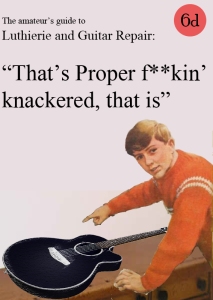We’ve all seen the memes about mechanics – and they’re only funny (like anything else), if there’s a degree of truth behind the joke. Like the “Going out for an English” sketch from Goodness Gracious Me – there’s a genuine observation in there about how English people behave in a restaurant after a skinfull. Not to say we’re all like it – but there’s just enough there for the joke to be funny.
And so to my little mock up!

I had a customer come in a little while ago with a guitar that had a bit of damage on it. He’d gone to a shop who had told him that the crack in the neck of his guitar was (and I quote) – “Dangerous”, and that he should simply dump the guitar and buy a new one.
This sort of thing makes me pretty angry really. I won’t name the shop, that wouldn’t be professional, and I have nothing in general against music shops at all – I’m sure if you want to buy an instrument the establishment in question is an excellent place to go. But mostly they don’t do repairs in house. In fact, only handful of shops do – for any kind of product. So much of what we buy these days is disposable, that repairing things is just not a ‘High Street Demand’ kind of service.
Now that’s not to say that you’ll never get good advice from a music shop when it comes to a broken instrument – there’s lots of folks out there who know their stuff. But think of it like this:
When you take your car to be serviced at a big dealership, the salesman comes out and says – “We’re cutting our overheads at the minute, so we had to fire all the mechanics. So I’m going to get the manager’s secretary on it right away. She’s never done it before but she’s seen loads of motors coming in and out of here over the years, how difficult can it be right?”
That’s what has happened to the music industry on the high street to a large degree. Their margins have been shrunk to a wafer thin veneer on the back of the reducing popularity of music as an occupation or hobby and the internet squeeze on prices. Very few retailers can actually afford to have a repair guy on standby just in case something comes in. A skilled craftsman won’t work for peanuts – and the tooling is expensive too.
So it has made more sense over the years for Luthiers (and in this I include the repair and servicing guys too), to become independent – get away from the high street to cut their own costs and therefore stay competitive against simple replacement of broken instruments.
But that makes it harder for the customer too. You have a relationship with your local shop, but they have a ‘guy they send out to’ – and you don’t know him. It’s not really in the shopkeeper’s interest for you to know him either, otherwise you could just bypass him and there goes his margin (and he’s squeezed bad enough as it is, though I do know some very honest music retailers who simply give out a local Luthier’s card, forgoing the chance of profit). So how do you know that you retailer’s tech is good?
‘You Don’t!’ You’re taking the thing totally on trust. So it’s really about the retailer. Do you totally trust your retailer. I have to be honest and say that over the years I have dealt with a few that I would have totally trusted, and fewer that I truly didn’t. The others I was ambiguous about.
So when it comes to looking at the independent sector, the guy working out of his house or small workshop – what is it you’re looking for?
Well firstly, don’t start with the internet. I have a very nice website – but it proves absolutely nothing about my competence really. The guy with the best Search Engine Optimisation is not necessarily the best luthier. If the website is incredibly flash – (and mine is actually pretty slick thanks to my good friend Simon Milner who is both a graphic designer and owner of one of my prototypes), don’t just take it for granted that the service is equally as classy. Ask around a bit and find out if anyone you know has used the repairer in question.
But even if you don’t have many friends locally, or you’re a bit new in town, then you have to book an appointment and take a look. What are you looking for?
To start with, just sit back and see what the guy has to say about your guitar. Tell him what your problem is but don’t necessarily propose the solution you had in mind. He doesn’t know whether you know about guitars or not. If you’re talking to a jerk, this is the moment he will try to con you into paying lots of money for something that doesn’t need to be done. If you’ve got some experience, that’s the moment when you pack your guitar back in it’s case and politely make your exit. Also, think about the value of the instrument. If the luthier is proposing very large repairs to a cheap instrument without actually pointing it the value relationship out, then do you want to be talking to this guy?
If the luthier proposes a solution you think seems reasonable, ask about what will be done in more detail. A good luthier won’t be scared to tell you what he’s going to do. Someone who is winging it will most likely be evasive. But don’t expect a step by step guide in ‘How to do this job yourself’!
Be wary of the over promise. When I have seen jobs come in where an over promise has been made and left unfulfilled, it’s often over repairs to finishes. If you have a truly old guitar – and it’s got dinks in the finish. Leave it alone!!!
One Gretsch came in here with buckle rash repaired with what looked like ‘Airfix’ paint.

It was much worse than the initial damage (which was just natural wear for a mid 60’s instrument). I didn’t repair it, I returned it to it’s originally damaged state). So when someone offers to repair something like a sunburst finish because you’ve gone through the colour, expect a significant portion of the guitar to be resprayed. If that’s not the case then it’s unlikely that the repair is going to be good. If you have a modern ‘Poly’ finished axe, the problem is even worse, because the finish is chemically cured – so repairs are rarely able to ‘return to new’. Repairs can be made reasonably invisible, but rarely under close inspection without large refinishing.
Get a price – not an estimate. For the vast majority of jobs, the Luthier knows exactly what is entailed in the work at hand. There are a few occasions where we step into the unknown, where we have to open up the guitar to have a look. Realistically, most Luthiers will have a look and then quote a price to fix. Some will charge a small investigation fee and that’s reasonable in some cases. I don’t do that personally, but my overheads are fairly light compared to Luthiers who work in urban areas for instance. However, don’t ever authorise work on your guitar without knowing the price. Sometimes I will quote a range – giving a maximum if everything is worst case. I think that’s more reasonable than quoting a low price and then going back to a customer when the job takes longer than anticipated. When we take on jobs, like any other trade, if we quote incorrectly then that’s OUR PROBLEM – not the customers’.
Can you see evidence of their work? It’s very rare that luthiers have nothing of their own that they have kept (though sometimes a luthier’s guitar can be a bit like a mechanic’s car). But they should be able to show you some evidence of work, even if it’s just pictures. Don’t be afraid to ask, a good Luthier will never be ashamed of his work. It’s harder for service/repair guys in this sense, but they will have a good catalogue of jobs behind them. You can never be 100% certain that every photo is genuine, but there you have to trust your instinct a little – we aren’t actors after all, we’re mostly just fine carpenters with some grounding in electronics!
So you’ve chosen your Luthier and the job has been done to your satisfaction. There’s one last thing you can do for your luthier and for your playing friends: Tell people about your Luthier.
Despite the impression that there are loads of us out there, it’s not really true.
And once we are gone, you’ll miss us.





